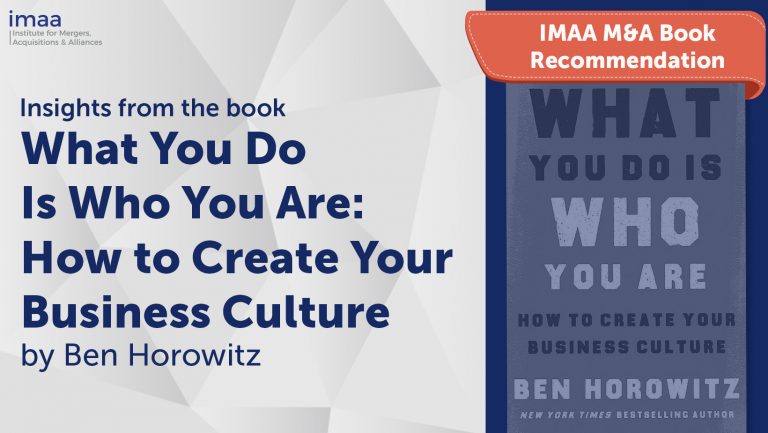
Blog What You do Is Who You Are: How to Create Your Business Culture by Ben Horowitz – IMAA M&A Book Recommendation
- Blog, IMAA M&A Book Recommendation
What You do Is Who You Are: How to Create Your Business Culture by Ben Horowitz – IMAA M&A Book Recommendation

SHARE:
Mergers and acquisitions (M&A) are complex procedures involving the consolidation of two or more organizations into one. Despite the importance of financial and strategic considerations, the human element frequently determines the success or failure of such endeavors. In his book “What You Do Is Who You Are,” Ben Horowitz examines the significance of culture and leadership in shaping the identity of an organization. The purpose of this article is to extract valuable lessons from the book and apply them to the context of mergers and acquisitions, highlighting the importance of nurturing a strong and aligned company culture during these transformative events.
Culture’s Role in M&A
In any M&A transaction, the integration of two distinct cultures is a crucial obstacle. Conflicting values, norms, and behaviors can impede post-merger integration if not carefully considered. “What You Do Is Who You Are” emphasizes the significance of defining and shaping a strong, cross-company culture. The book emphasizes that leaders must cultivate a shared identity to align employees around a common goal. This strategy promotes collaboration and facilitates the M&A integration process.
Cultural Values Defined
Organizations must clearly define their cultural values and establish them as non-negotiable to successfully navigate mergers and acquisitions. The emphasis of Horowitz’s book – “What You Do Is Who You Are” is that cultural values should not be mere platitudes, but rather practical guidelines that influence employee conduct. During mergers and acquisitions, both the acquiring and the acquired company must evaluate their cultural values and identify areas of overlap and potential misalignment. By engaging employees and aligning on shared values, the integration process is facilitated, resistance is mitigated, and a cohesive new culture is created.
Leadership and Responsibility
Transactions involving mergers and acquisitions require strong leadership to oversee the process and ensure successful integration. In the face of adversity, Horowitz argues that leaders must assume responsibility for shaping the company culture. Leaders set an example for others to follow by embodying the cultural values themselves. In the context of mergers and acquisitions, the leaders of both organizations must collaborate to cultivate a unified culture. They must communicate accurately, build trust, and align their actions with the cultural values they intend to advance. Leaders shape the perception of the new entity through their words and actions, aiding employees in navigating the uncertainties of change.
Transparency and Communication
Effective communication is essential during M&A to address employee uncertainties and anxieties. Horowitz emphasizes the significance of transparent and honest communication in forming the identity of an organization. Both acquiring and acquired companies should establish channels for open communication, allowing employees to express their concerns, pose questions, and exchange ideas. By fostering a transparent environment, businesses can develop trust, conquer fears, and improve the integration process. Regular updates on progress, cultural initiatives, and major milestones should be communicated to maintain employee engagement.
Learning and Adjusting Continuously
In a business environment that is constantly evolving, the ability to learn and adapt is crucial. The book by Horowitz stresses the need for organizations to adopt a growth mindset and be receptive to continuous learning. M&A transactions provide companies with a unique opportunity to learn from one another’s strengths, best practices, and experiences. By promoting the cross-pollination of ideas and practices, organizations can foster a learning and innovative culture. This not only improves the process of integration, but also positions the newly formed entity for long-term success.
Key Takeaway
Mergers and acquisitions are transformative events that necessitate thorough consideration of the human factor. In his book “What You Do Is Who You Are,” Ben Horowitz emphasizes the importance of culture and leadership in determining the identity of an organization. By collecting lessons from the book and applying them to the context of mergers and acquisitions, it becomes clear that a strong and congruent culture is essential for successful integration. M&A success requires defining cultural values, demonstrating leadership, nurturing transparent communication, and promoting continuous learning. While financial factors may dominate the M&A landscape, organizations that prioritize and invest in the cultural aspects of integration are more likely to achieve sustainable development and maximize the potential of mergers and acquisitions.
Want more book recommendations? Check out our other posts here.
- Tags: M&A, Mergers and Acquisitions


Stay up to date with M&A news!
Subscribe to our newsletter


